Geoheritage and Geotourism in Regions with Extinct Volcanism in Germany; Case Study Southwest Germany with UNESCO Global Geopark Swabian Alb
Abstract
1. Introduction
2. Volcanic Geoheritage in Germany
3. Geotourism and Volcanism in Germany
3.1. Geopark Vulkaneifel and Geopark Laacher See as Examples of an Intensive Valorization of Tertiary Volcanism
3.2. Geo-Nature Park Bergstraße-Odenwald as an Example for a Low Geotouristic Valorization of Volcanism
3.3. Geotouristic Valorization of Volcanism Outside of Geoparks
4. Case Study Southwest Germany
4.1. UNESCO Global Geopark Swabian Alb—A Well-Camouflaged Potential
Geotouristic Valorization of Tertiary Volcanism in the UNESCO Global Geopark Swabian Alb
4.2. Kaiserstuhl—Isolated Volcano with Viticulture
4.3. Hegau: Fire, Ice and Water; Volcano Trails and Tours
5. Resulting Requirements
5.1. Professionalization of Geo-Didactics, Geotourism and Geotope Protection
- Awaken and maintain interest in geothemes.
- Target group orientation.
- Adequate mediation techniques, including understandable language.
- Regional focus on local characteristics.
- Take home message [6].
5.2. Geotourism Offers, Regional Added Value and Geotope Protection
6. Conclusions
Funding
Acknowledgments
Conflicts of Interest
References
- Hopfinger, H. Geographie der Freizeit und des Tourismus. In Geographie: Physische Geographie und Humangeographie; Gebhardt, H., Glaser, R., Radtke, U., Reuber, P., Eds.; Spektrum Akademischer Verlag: Heidelberg, Germany, 2011; pp. 1041–1043. ISBN 978-3-8274-2816-5. [Google Scholar]
- Dowling, R.; Newsome, D. Handbook of Geotourism; Edward Elgar Publishing: Cheltenham, UK, 2018; ISBN 1785368850. [Google Scholar]
- Newsome, D.; Dowling, R. Geoheritage and Geotourism. In Geoheritage: Assessment, Protection, and Management; Reynard, E., Brilha, J., Eds.; Elsevier: Amsterdam, The Netherlands, 2018; pp. 305–321. ISBN 9780128095317. [Google Scholar]
- Dowling, R.; Newsome, D. Geotourism; Routledge: Amsterdam, The Netherlands, 2010; ISBN 978-1906884093. [Google Scholar]
- Hose, T. Geotourism–Appreciating the deep time of landscapes. In Niche Tourism, Contemporary Issues, Trends and Cases; Novelli, M., Ed.; Routledge: London, UK, 2004; pp. 27–37. [Google Scholar]
- Megerle, H. Geotourismus. Innovative Ansätze zur touristischen Inwertsetzung und nachhaltigen Regionalentwicklung; Kersting-Verlag: Rottenburg am Neckar, Germany, 2008; ISBN 3-937559-09-4. [Google Scholar]
- Reynard, E.; Coratza, P. Geomorphosites; Friedrich-Pfeil-Verlag: Munich, Germany, 2009; ISBN 978-3899370942. [Google Scholar]
- Gray, M. Geodiversity. Valuing and Conserving Abiotic Nature, 2nd ed.; Wiley-Blackwell: Chennai, India, 2013; ISBN 978-0470742143. [Google Scholar]
- Reynard, E.; Brilha, J. (Eds.) Geoheritage: Assessment, Protection, and Management; Elsevier: Amsterdam, The Netherlands, 2018; ISBN 9780128095317. [Google Scholar]
- Bourseillier, P.; Durieux, J. Volcanoes; Harry, N., Ed.; Abrams, Inc.: New York, NY, USA, 2002; ISBN 978-0810916999. [Google Scholar]
- Erfurt-Cooper, P.; Cooper, M. Volcano & Geothermal Tourism. Sustainable Geo-Ressources for Leisure and Recreation; Earthscan: New York, NY, USA, 2010; ISBN 978-1138994119. [Google Scholar]
- Erfurt-Cooper, P. Active geothermal and volcanic environments as tourist destinations. In Global Geotourism Perspectives; Dowling, R., Newsome, D., Eds.; Goodfellow Publishers: Oxford, UK, 2010; pp. 33–38. ISBN 978-1906884178. [Google Scholar]
- Pijet-Migon, E.; Migon, P. Promoting and Interpreting Geoheritage at the Local Level–Bottom-Up Approach in the Land of Extinct Volcanoes, Sudetes, SW Poland. Geoheritage 2019, 11, 1227–1236. [Google Scholar] [CrossRef]
- Migon, P.; Pijet-Migon, E. Overlooked Geomorphological Component of Volcanic Geoheritage—Diversity and Perspectives for Tourism Industry, Pogórze Kaczawskie Region, SW Poland. Geoheritage 2016, 8, 333–350. [Google Scholar] [CrossRef]
- Rózycka, M.; Migon, P. Customer-Oriented Evaluation of Geoheritage—On the Example of Volcanic Geosites in the West Sudetes, SW Poland. Geoheritage 2018, 10, 23–37. [Google Scholar] [CrossRef]
- Erfurt-Cooper, P. Volcanic Tourist Destinations (Geoheritage, Geoparks and Geotourism); Springer: Berlin/Heidelberg, Germany, 2014; ISBN 978-3642161902. [Google Scholar]
- Meschede, M. Geologie Deutschlands Ein Prozessorientierter Ansatz; Springer-Spektrum: Berlin/Heidelberg, Germany, 2015; ISBN 978-3662452974. [Google Scholar]
- Schmincke, H.-U. Vulkane der Eifel. Aufbau, Entstehung und Heutige Bedeutung; Spektrum Akademischer Verlag: Heidelberg, Germany, 2009; ISBN 978-3827423665. [Google Scholar]
- Zöller, L. Die Physische Geographie Deutschlands; Wissenschaftliche Buchgesellschaft: Darmstadt, Germany, 2017; ISBN 978-3534268689. [Google Scholar]
- Rothe, P. Die Geologie Deutschlands. 48 Landschaften im Portrait, 5th ed.; Wissenschaftliche Buchgesellschaft: Darmstadt, Germany, 2019; ISBN 978-3534271290. [Google Scholar]
- Eberle, J.; Eitel, B.; Blümel, W.; Wittmann, P. Deutschlands Süden vom Erdmittelalter bis zur Gegenwart; Spektrum Akademischer Verlag: Heidelberg, Germany, 2010; ISBN 978-3827425942. [Google Scholar]
- Heizmann, E.; Schmidt, F. Tertiärer Vulkanismus auf der Schwäbischen Alb und im Hegau. In Erdgeschichte mitteleuropäischer Regionen (2). Vom Schwarzwald zum Ries; Heizmann, E., Ed.; Verlag Dr. Friedrich Pfeil: Munich, Germany, 1998; pp. 177–190. ISBN 978-3931516338. [Google Scholar]
- Reischmann, T. Tertiärer Vulkanismus. In Stratigraphie von Deutschland IX. Tertiär Teil 1: Oberrheingraben und benachbarte Tertiärgebiete; Deutsche Stratigraphische Kommission, Ed.; Schweizerbart Science Publisher: Stuttgart, Germany, 2011; pp. 16–30. ISBN 978-3510492237. [Google Scholar]
- Geyer, M.; Nitsch, E.; Simon, T.; Geyer, O.; Gwinner, M. Geologie von Baden-Württemberg, 5th ed.; E. Schweizerbart’sche Verlagsbuchhandlung: Stuttgart, Germany, 2011; ISBN 978-3510652679. [Google Scholar]
- Kagermeier, A. Experience orientated staging of nature oriented and geotourism attractions. A case study from the European Geopark Vulkaneifel. In Tourism Development in Low Mountain Ranges; Ka-germeier, A., Willms, J., Eds.; Meta-GIS-Systems: Mannheim, Germany, 2010; pp. 23–46. ISBN 978-3936438345. [Google Scholar]
- Zouros, N. Geomorphosites within geoparks. In Geomorphosites; Reynard, E., Coratza, P., Eds.; Frie-drich-Pfeil-Verlag: Munich, Germany, 2009; pp. 105–118. ISBN 978-3899370942. [Google Scholar]
- European Geoparks Network European Geoparks. Available online: http://www.europeangeoparks.org/ (accessed on 16 September 2020).
- Geo-Union Alfred Wegener Stiftung Nationaler Geopark. Available online: http://www.nationaler-geopark.de/geopark/nationale-geoparks/die-16-nationalen-geoparks.html (accessed on 2 October 2020).
- Deutsche UNESCO-Kommission e.V. UNESCO-Geoparks. Vom Geologischen Erbe zu Einer Nachhaltigen Zukunft. Available online: https://www.unesco.de/sites/default/files/2020-06/Geoparks_Imagebroschuere_2020.pdf (accessed on 2 October 2020).
- Bétard, F. Géodiversité, Biodiversité et Patrimoines Environnementaux: De la Connaissance à la Conservation et à la Valorization; Mémoire d‘Habilitation à Diriger des Recherches; Université Sorbonne Paris Cité: Paris, France, 2017. [Google Scholar]
- Girault, Y. Les Géoparcs Mondiaux UNESCO. Une Mise en Tension Entre Développement des Territoires et Mise en Valeur du Patrimoine; ISTE Editions: Surrey, UK, 2019; ISBN 978-1784055622. [Google Scholar]
- Arbeitsgemeinschaft Deutscher Geoparks (AdG) Geoparks in Deutschland. Available online: https://www.geoparks-in-deutschland.de/de/suchergebnis.php?var=Vulkanismus&Zeitalter=# (accessed on 23 July 2020).
- Geopark Vogelsberg. VulkanErleben. Available online: https://www.geopark-vogelsberg.de/vulkanerleben.html (accessed on 9 September 2020).
- Abratis, M.; Viereck, L.; Büchner, J.; Tietz, O. Route to the Volcanoes in Germany. Conceptual model for a geotourism project interconnecting geosites of Cenozoic volcanism. Zeitschrift der Deutschen Gesellschaft für Geowissenschaften 2015, 2, 161–185. [Google Scholar] [CrossRef]
- Podbregar, N. 15 Nationale Geoparks mit Tollen Touren und Wertvollen Tipps. Bild der Wissenschaft. Spezial Geoparks. Reiseführer Erdgeschichte. Available online: http://www.nationaler-geopark.de/fileadmin/downloads/geoparks/bdw_Geoparks_Inhalt.pdf (accessed on 2 October 2020).
- Vulkaneum. Vulkaneum. Available online: https://www.vulkaneum.com/ (accessed on 2 October 2020).
- Deutsche Vulkanologische Gesellschaft. Available online: https://www.vulkane.de/index.html (accessed on 16 September 2020).
- Schmitz, S. Geotourismus in der Eifel. Konzepte, Auswirkungen und Perspektiven; Verlag Dr. Kovac: Hamburg, Germany, 2015; ISBN 978-3830082040. [Google Scholar]
- Erfurt-Cooper, P. The Vulkaneifel in Germany. A Destination for Geotourism. In Volcano & Geo-Thermal Tourism. Sustainable Geo-Ressources for Leisure and Recreation; Erfurt-Cooper, P., Cooper, M., Eds.; Earthscan: New York, NY, USA, 2010; pp. 281–285. ISBN 978-1138994119. [Google Scholar]
- Frey, M.-L. Vulkaneifel European Geopark–Langjährige geotouristische Erfahrungen. In Geoforum 2003: Geotope-Geoparks-Geotourismus; Quade, H., Ed.; Schweizerbarth: Stuttgart, Germany, 2003; pp. 61–67. ISBN 978-3510959129. [Google Scholar]
- Geo-Union Alfred Wegener Stiftung. Aus 1 mach 2. Nationaler GeoPark Vulkaneifel Teilt Sich in Zwei Geoparks. Available online: http://www.nationaler-geopark.de/geopark/aktuelles/einzelansicht/article/219.html (accessed on 2 October 2020).
- Lauterbach, M.; Kumerics, C. Vulkane, Schluchten, Höhlen. Geologische Naturwunder in Deutschland; Wissenschaftliche Buchgesellschaft: Darmstadt, Germany, 2014; ISBN 978-3806231663. [Google Scholar]
- Bitschene, P. Edutainment with basalt and volcanoes. The Rockeskyller Kopf example in the Westeifel Volcanic Field/Vulkaneifel European Geopark Germany. Z. Dtsch. Ges. Geowiss. 2015, 166, 187–193. [Google Scholar] [CrossRef]
- Vulkan-Brauerei. Führungen im Tiefsten Bierkeller der Welt–Das Ganz Besondere Erlebnis. Available online: https://www.vulkan-brauerei.de/aktionen-und-events/erlebnis-kellerfuehrung/ (accessed on 16 September 2020).
- Clement, T. Korallen, Maare, Mineralwasser–das geotouristische Angebot in der Vulkaneifel In Geotourismus. Innovative Ansätze zur touristischen Inwertsetzung und nachhaltigen Regionalentwicklung; Megerle, H., Ed.; Kersting-Verlag: Rottenburg am Neckar, Germany, 2008; pp. 185–192. ISBN 3-937559-09-4. [Google Scholar]
- Simper, G. Vulkanismus Verstehen und Erleben; Feuerland-Verlag: Feuerbach, Germany, 2005; ISBN 978-3000151170. [Google Scholar]
- Geo-Naturpark Bergstraße Odenwald. Available online: http://www.geo-naturpark.net/deutsch/willkommen/kommunen/neckar-odenwald/waldbrunn.php (accessed on 16 September 2020).
- Welterbe Grube Messel. Grube Messel. Available online: https://grube-messel.de/ (accessed on 28 July 2020).
- Look, E.; Feldmann, L. Faszination Geologie. Die bedeutendsten Geotope Deutschlands; Schweizerbart: Stuttgart, Germany, 2007; ISBN 978-3510652211. [Google Scholar]
- Frohn, H.-W.; Schmoll, F. Amtlicher Naturschutz. Von der Errichtung der “Staatlichen Stelle für Naturdenkmalpflege” bis zur “ökologischen Wende” in den 1970er Jahren. Nat. Landsch. 2006, 1, 2–7. [Google Scholar]
- Geyer, O.; Gwinner, M. Geologie von Baden-Württemberg, 4th ed.; Schweizerbart: Stuttgart, Germany, 1991; ISBN 978-3510651467. [Google Scholar]
- Schöttle, M. Geotope im Regierungsbezirk Tübingen. Available online: File:///C:/Users/HeMegerle/Downloads/45542-Steckbrief.pdf (accessed on 2 October 2020).
- Schöttle, M. Geotope im Regierungsbezirk Freiburg; Greiserdruck: Karlsruhe, Germany, 2005; ISBN 3-88251-293-8. [Google Scholar]
- Schöttle, M. Geologische Naturdenkmale im Regierungsbezirk Karlsruhe, 2nd ed.; Präzisdruck: Karlsruhe, Germany, 2000; ISBN 3-88251-079-X. [Google Scholar]
- Burgmeister, G.; Schöttle, M. Geotope im Regierungsbezirk Stuttgart; Kraft-Druck: Ettlingen, Germany, 2002; ISBN 3-88251-283-0. [Google Scholar]
- Megerle, H.; Pietsch, D. Geotopschutz als Stiefkind des Naturschutzes. Geoparks im Spannungsfeld von Schutz und Nutzung. Nat. Landsch. 2019, 51, 174–182. [Google Scholar]
- Landesamt für Denkmalpflege im Regierungspräsidium Tübingen, Höhlen der ältesten Eiszeitkunst. Welterbenominierung; Scheufele Druck und Medien: Stuttgart, Germany, 2016. [Google Scholar]
- Schweigert, G. Der Scharnhäuser Vulkan–eine Bestandsaufnahme 125 Jahre nach Brancos Beschreibung. Jahresh. Ges. Nat. Württemberg 2018, 174, 191–207. [Google Scholar]
- Roser, W.; Mauch, J.; Rosenberger, F. Vulkanalb. Unterwegs in der Landschaft des Schwäbischen Vulkans; GO-Verlag: Kirchheim unter Teck, Germany, 2016; ISBN 978-3925589669. [Google Scholar]
- Rosendahl, W.; Correa, M.; Gruner, C.; Müller, T. Der Böttinger Marmor. Schwäbisches Geojuwel aus heißen Quellen; Verlag Friedrich Pfeil: Munich, Germany, 2013; ISBN 978-3899371680. [Google Scholar]
- Lauterbach, M.; Kumerics, C. Blautopf, Kaiserstuhl und Katzenbuckel. Naturwunder in Baden-Württemberg; Wissenschaftliche Buchgesellschaft: Darmstadt, Germany, 2017; ISBN 978-3806234817. [Google Scholar]
- Hauff, R.; Megerle, A.; Megerle, H.; Dieter, A.; Behmel, H.; Kraus, U.; Klumpp, B. Abenteuer Geologie. Available online: https://www.geopark-alb.de/pdf/Geopark_Broschueren/geopark_imagebroschuere_05_2018_rz_internet.pdf (accessed on 2 October 2020).
- Pietsch, D.; Huth, T. Geotopmanagementkonzept; Geotopdokumentation 2017; UNESCO Global Geopark Schwäbische Alb: Marktstraße, Schelklingen, Germany, 2017; unpublished report. [Google Scholar]
- Megerle, H.; Schrembs, R. Ökonomische Effekte in den europäischen Nationalen Naturlandschaften – Beiträge der Geoparke und des Geotourismus für eine nachhaltige Regionalentwicklung; Thüringer Ministerium für Landwirtschaft, Naturschutz und Umwelt, Ed.; Weltnaturerbe Buchenwälder: Saalfeld, 2009; pp. 247–257. [Google Scholar]
- Selmi, L.; Coratza, P.; Gauci, R.; Soldati, M. Geoheritage as a Tool for Environmental Management: A Case Study in Northern Malta (Central Mediterranean Sea). Resources 2019, 8, 168. [Google Scholar] [CrossRef]
- Cappadonia, C.; Coratza, P.; Agnesi, V.; Soldati, M. Malta and Sicily Joined by Geoheritage Enhancement and Geotourism within the Framework of Land Management and Development. Geosci. J. 2018, 8, 253. [Google Scholar] [CrossRef]
- Huth, T.; Junker, B. Geotouristische Karte Nationaler Geopark Schwäbische Alb mit Umgebung; Reiff Druck: Munich, Germany, 2003. [Google Scholar]
- Huth, T.; Junker, B. Geotouristische Karte Schwarzwald mit Umgebung; Reiff Druck: Munich, Germany, 2004; ISBN 3-00-014219-3. [Google Scholar]
- Megerle, H. Naturerlebnispfade–Neue Medien der Umweltbildung und des Landschaftsbezogenen Tourismus? Tübinger Geographische Studien: Tübingen, Germany, 2003; ISBN 9783881210355. [Google Scholar]
- Krafft, M. Führer zu den Vulkanen Europas. Band 2: Deutschland. Frankreich; Ferdinand Enke Verlag: Stuttgart, Germany, 1984; ISBN 978-3827412515. [Google Scholar]
- Günther, D. Der Schwarzwald und seine Umgebung. Geologie-Mineralogie-Bergbau-Umwelt und Geotourismus; Sammlung geologischer Führer; Band 102. Gebr; Borntraeger: Stuttgart, Germany, 2010; ISBN 978-3443150884. [Google Scholar]
- DWIF, e.V. Wirtschaftsfaktor Tourismus für die Schwäbische Alb, unpublished report. 2017.
- Geopark Schwäbische Alb. Geotouristisches Besucherlenkungskonzept für den Geopark Schwäbische Alb, unpublished report. 2017.
- Roth, S. Masterplan GeoPark Schwäbische Alb e.V. 2015–2020, unpublished report. 2015.
- Megerle, H.; Pietsch, D. Consequences of overlapping territories between large scale protection areas and Geoparks in Germany: Opportunities and risks for geoheritage and geotourism. Ann. Géographie 2017, 717, 598–624. [Google Scholar] [CrossRef]
- Kommission Kultur der Internationalen Bodenseekonferenz (Ed.) Feuer, Eis und Wasser, Streifzüge durch die Landschaft der Bodenseeregion. Available online: http://www.bodenseekonferenz.org/bausteine.net/file/showfile.aspx?downdaid=8597 (accessed on 30 October 2020).
- Ebers, S.; Laux, L.; Kochanek, H. Vom Lehrpfad zum Erlebnispfad–Handbuch für Naturerlebnispfade; Naturschutzzentrum Hessen: Wetzlar, Germany, 1998; ISBN 9783926871336. [Google Scholar]
- Frey, M.-L. 15 Jahre Geotourismus–Ansätze, Erfolge, Perspektiven. In Geowissenschaften und Öffentlichkeit; Kruhl, J., Birkenhauer, J., Lagally, U., Lehrberger, G., Eds.; Deutsche Gesellschaft Für Geowissenschaften: Hannover, Germany, 2003; pp. 24–26. ISBN 3-932537-00-9. [Google Scholar]
- Wölfl, C. Grundlagen für die Planung geodidaktischer Angebote In Geotope–Bausteine der Regionalentwicklung; Rosendahl, W., Junker, B., Megerle, A., Vogt, J., Eds.; Deutsche Gesellschaft Für Geowissenschaften: Hannover, Germany, 2006; pp. 82–86. ISBN 3-932537-40-8. [Google Scholar]
- Tilden, F. Interpreting Our Heritage, 3rd ed.; The University of North Carolina Press: Chapel Hill, NC, USA, 1977; ISBN 0-8078-4016-5. [Google Scholar]
- Megerle, H.; Pietsch, D. Chancen und Herausforderungen für Geotourismus, Geotopschutz und Geodidaktik am Beispiel des UNESCO Global Geopark Schwäbische Alb. Geogr. Rundsch. 2017, 10, 26–31. [Google Scholar]
- Martin, S. Valoriser le Géopatrimoine par la Médiation Indirecte et la Visualisation des Objets Géomorphologiques, Géovisions 41; Université de Lausanne: Lausanne, Switzerland, 2013; ISBN 978-2-940368-17-4. [Google Scholar]
- Joyce, B. Geomorphosites and Volcanism. In Geomorphosites; Reynard, E., Coratza, P., Eds.; Friedrich-Pfeil-Verlag: Munich, Germany, 2009; pp. 175–188. ISBN 978-3899370942. [Google Scholar]
- Giusti, C. Introduction to the thematic issue: “From Geosites to Geomorphosites: How to decode the landscape? Geodynamic processes, surficial features and landforms, past and present environments”. Géomorphologie 2010, 2, 123–130. [Google Scholar] [CrossRef]
- Reynard, E.; Panizza, M. Géomorphosites: Definition, evaluation et cartographie. Une introduction. Géomorphologie 2005, 3, 177–180. [Google Scholar] [CrossRef]
- Wardenbach, T.; Schröder, V.; Lücke, M. Geotopschutz in der kommunalen Landschaftsplanung am Beispiel der Stadt Wuppertal. Nat. Landsch. 2009, 84, 496–501. [Google Scholar]
- Megerle, H.; Beuter, A. La protection des géotopes et le géotourisme–des intérêts contradictoires ou une préoccupation commune. In Les Géosciences au Service de la Société, Actes du Colloque en L‘honneur du Professeur Michel Marthaler; Reynard, E., Laigre, L., Kramar, N., Eds.; Institut de Géographie, Université de Lausanne: Lausanne, Switzerland, 2012; pp. 76–90. ISBN 978-2-940368-12-9. [Google Scholar]
- Härtling, J.; Meier, I. Economic Effects of Geotourism in the Geopark TERRA.vita, Northern Germa-ny. Available online: http://citeseerx.ist.psu.edu/viewdoc/download;jsessionid=430087D1A7EC628BD0B62AC19C594DA1?doi=10.1.1.380.1102&rep=rep1&type=pdf (accessed on 5 October 2020).
- INDECON An Economic Review of the Irish Geoscience Sector. Available online: https://www.leisuresolutions.com.au/wp-content/uploads/2015/02/Indecon_Economic_Review_of_Irish_Geoscience_Sector_Nov2017.pdf (accessed on 5 October 2020).
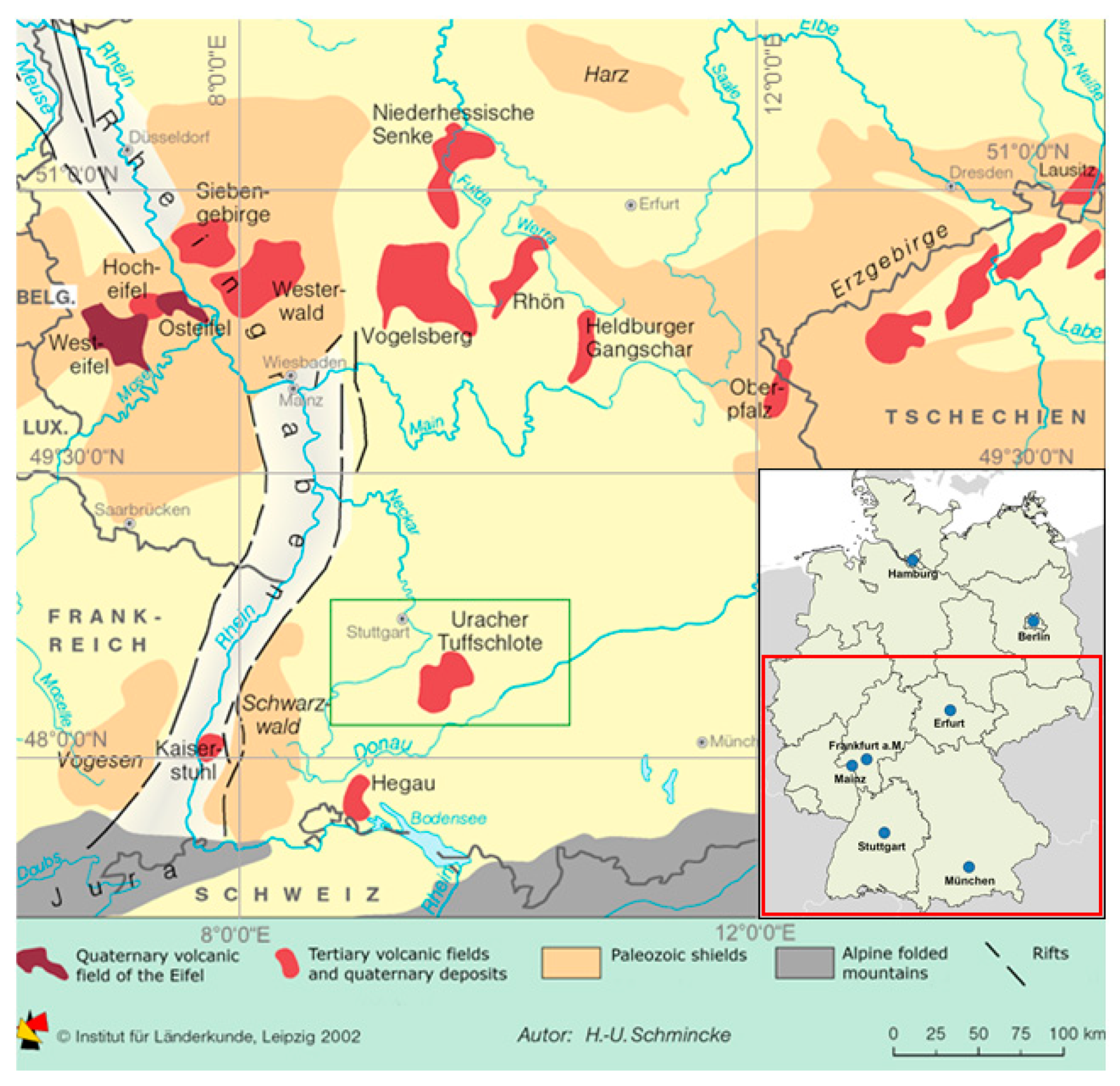
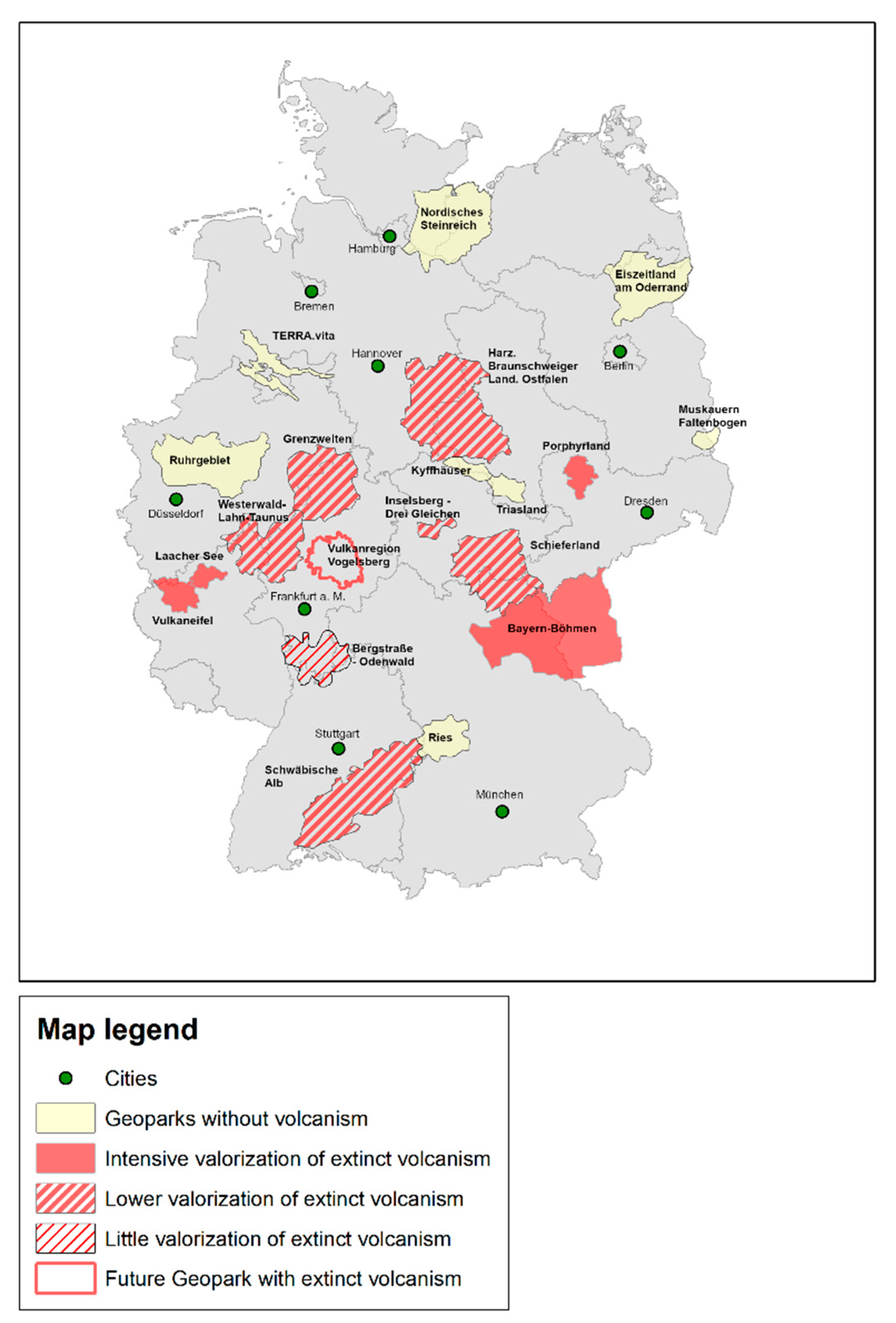
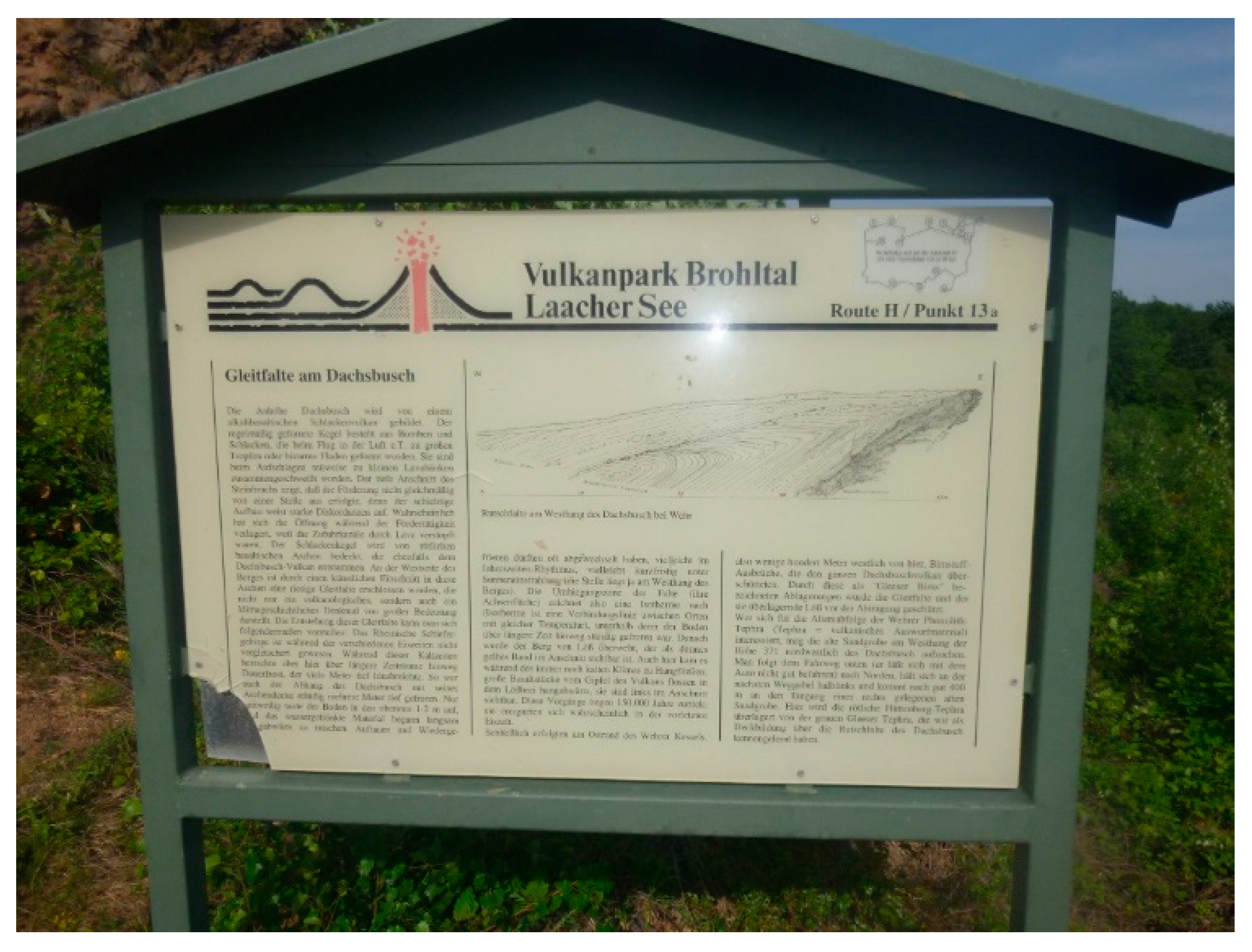
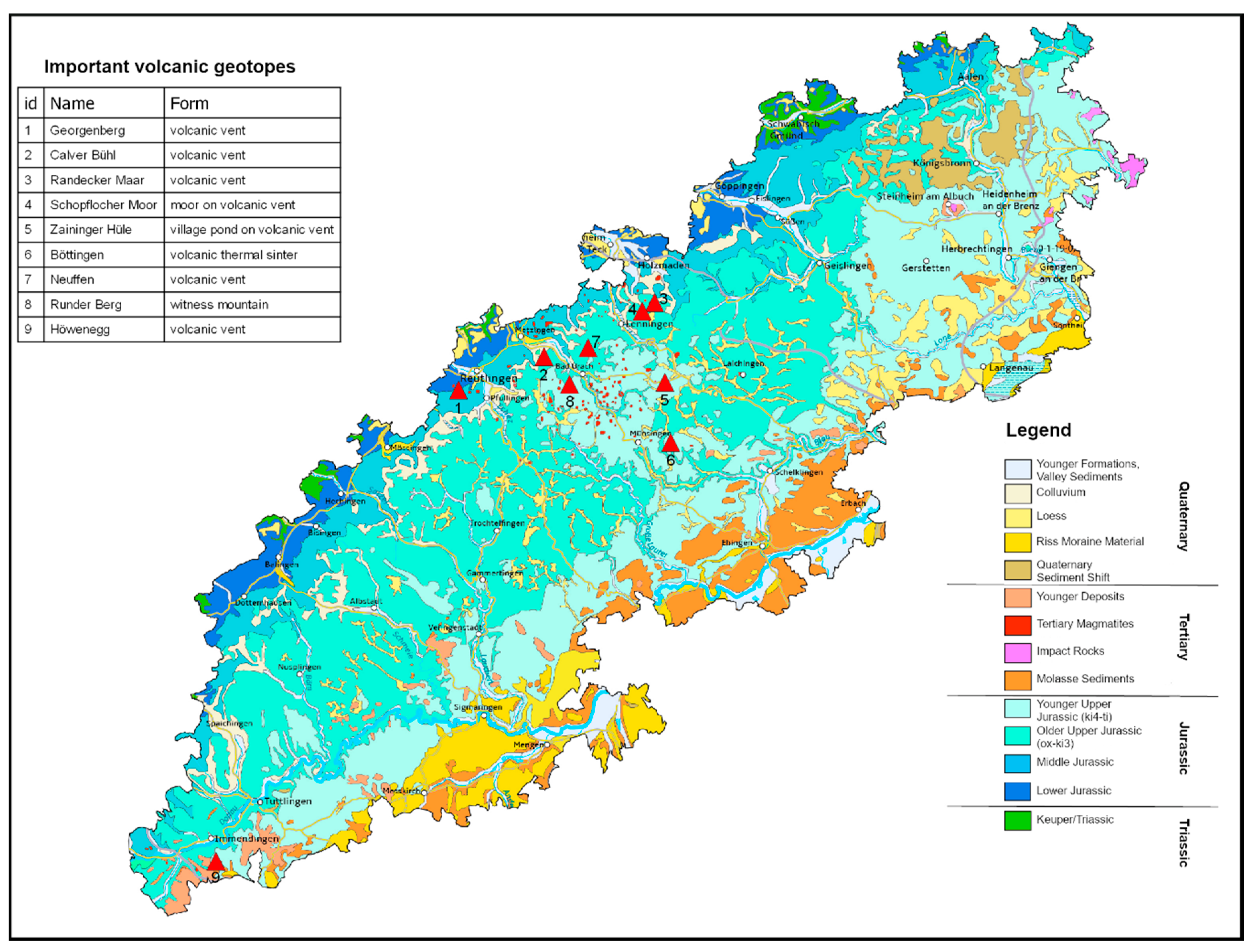
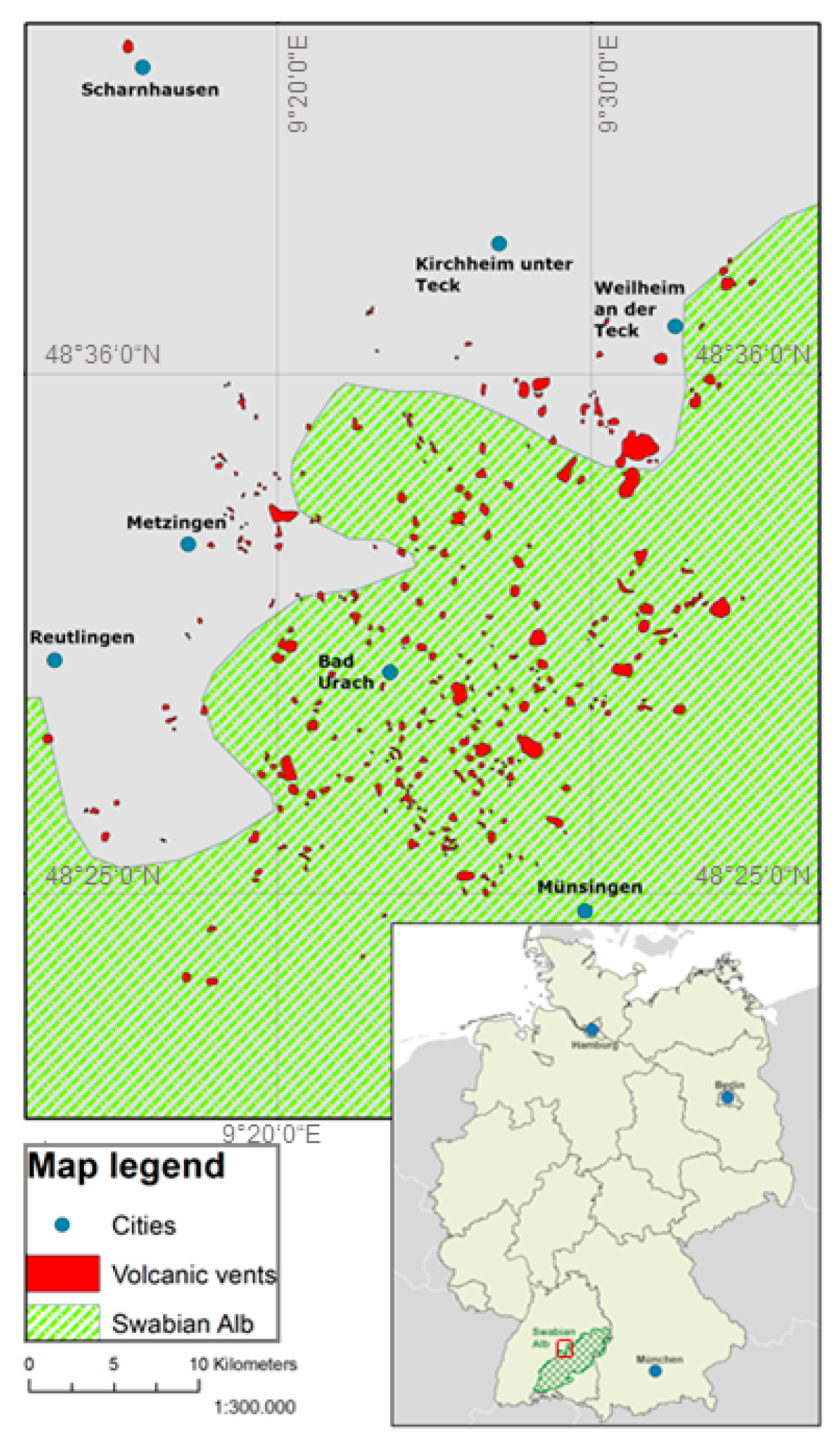
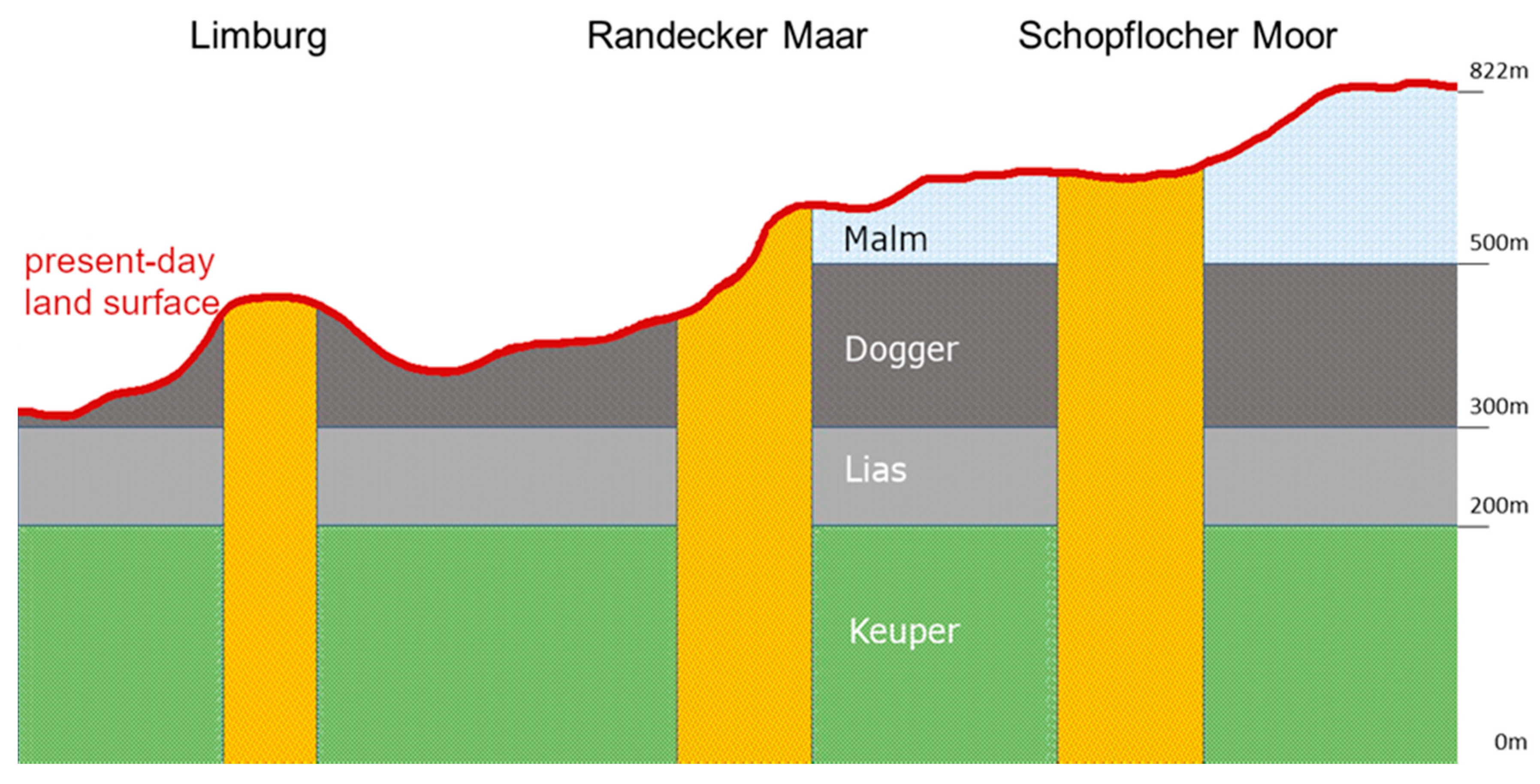
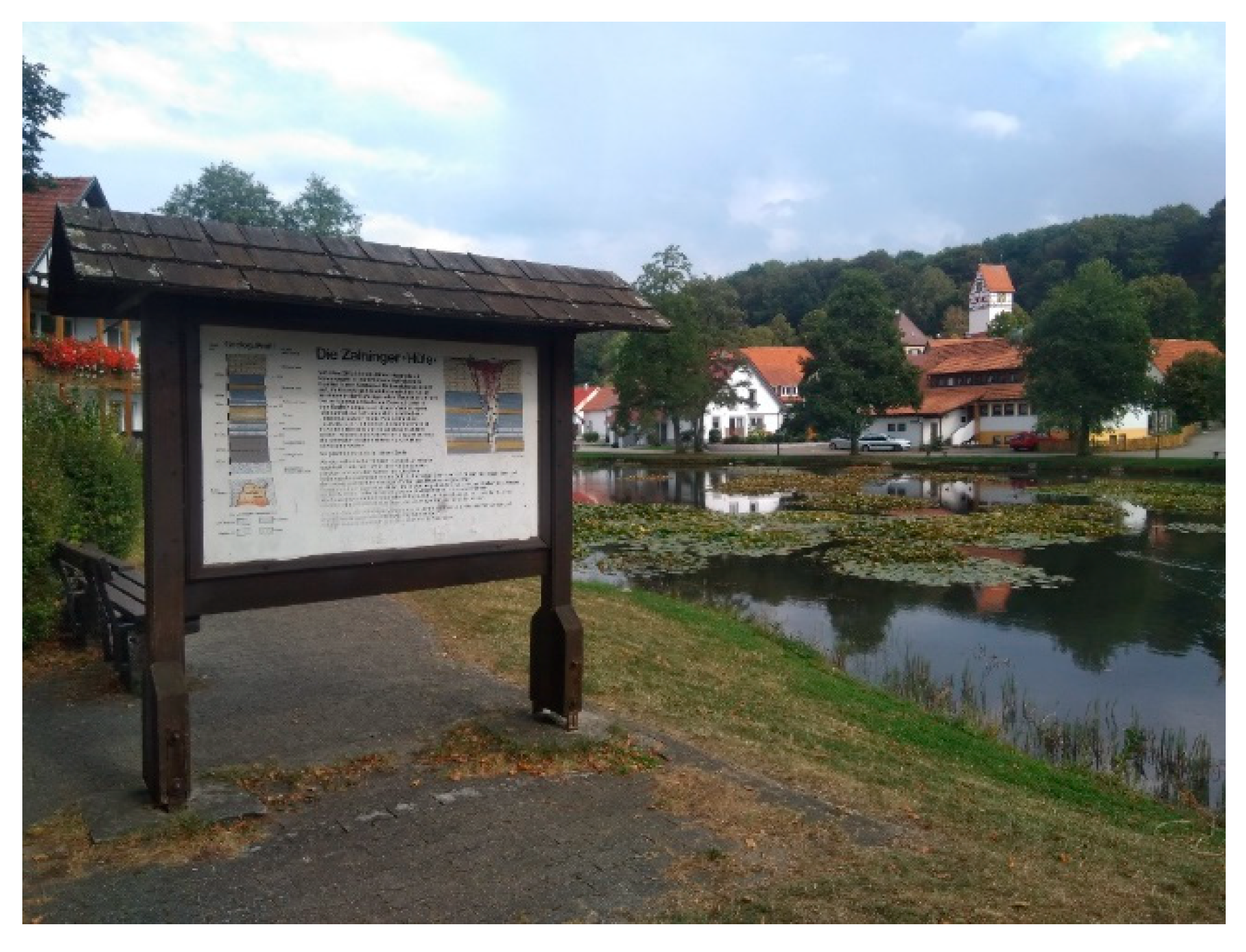
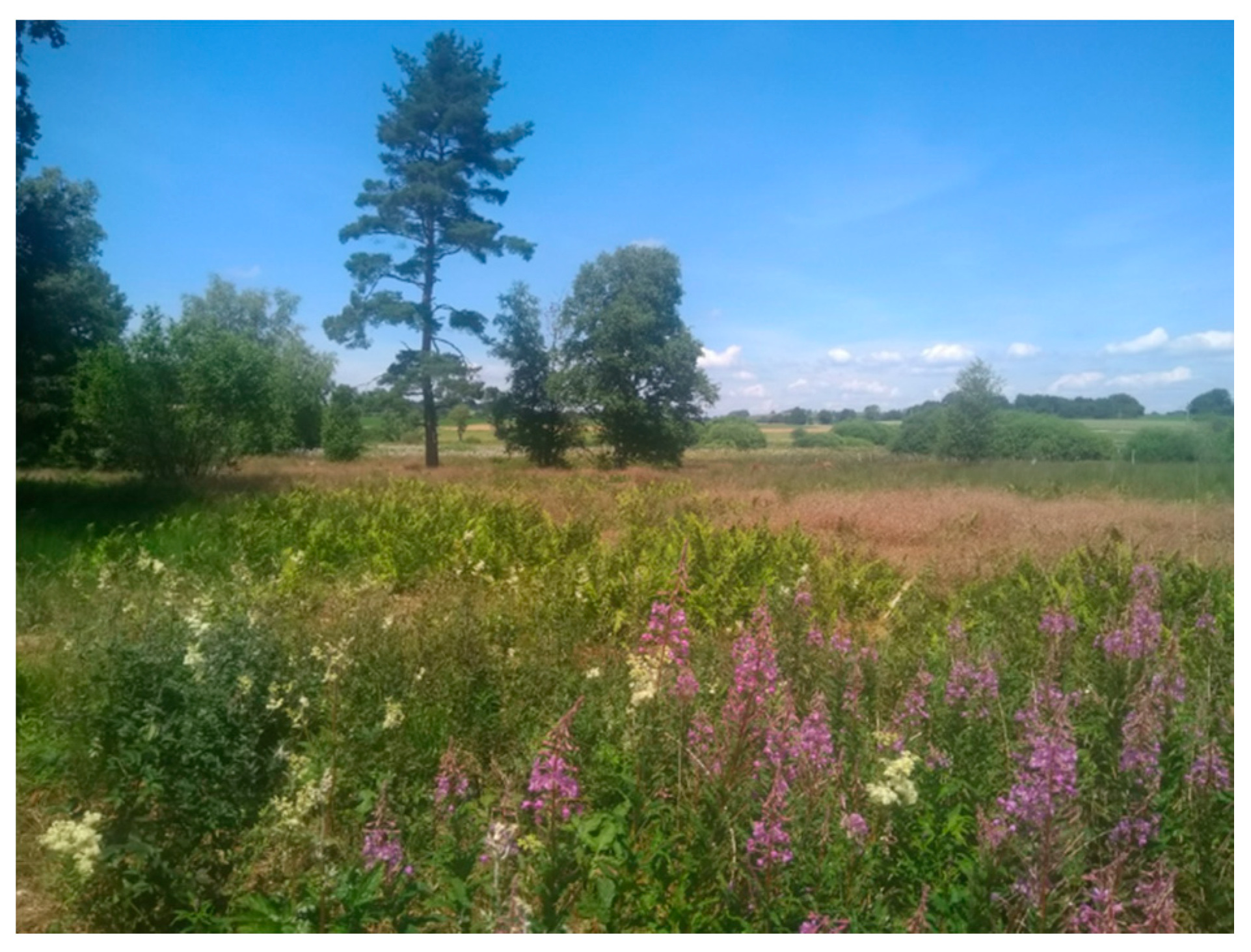

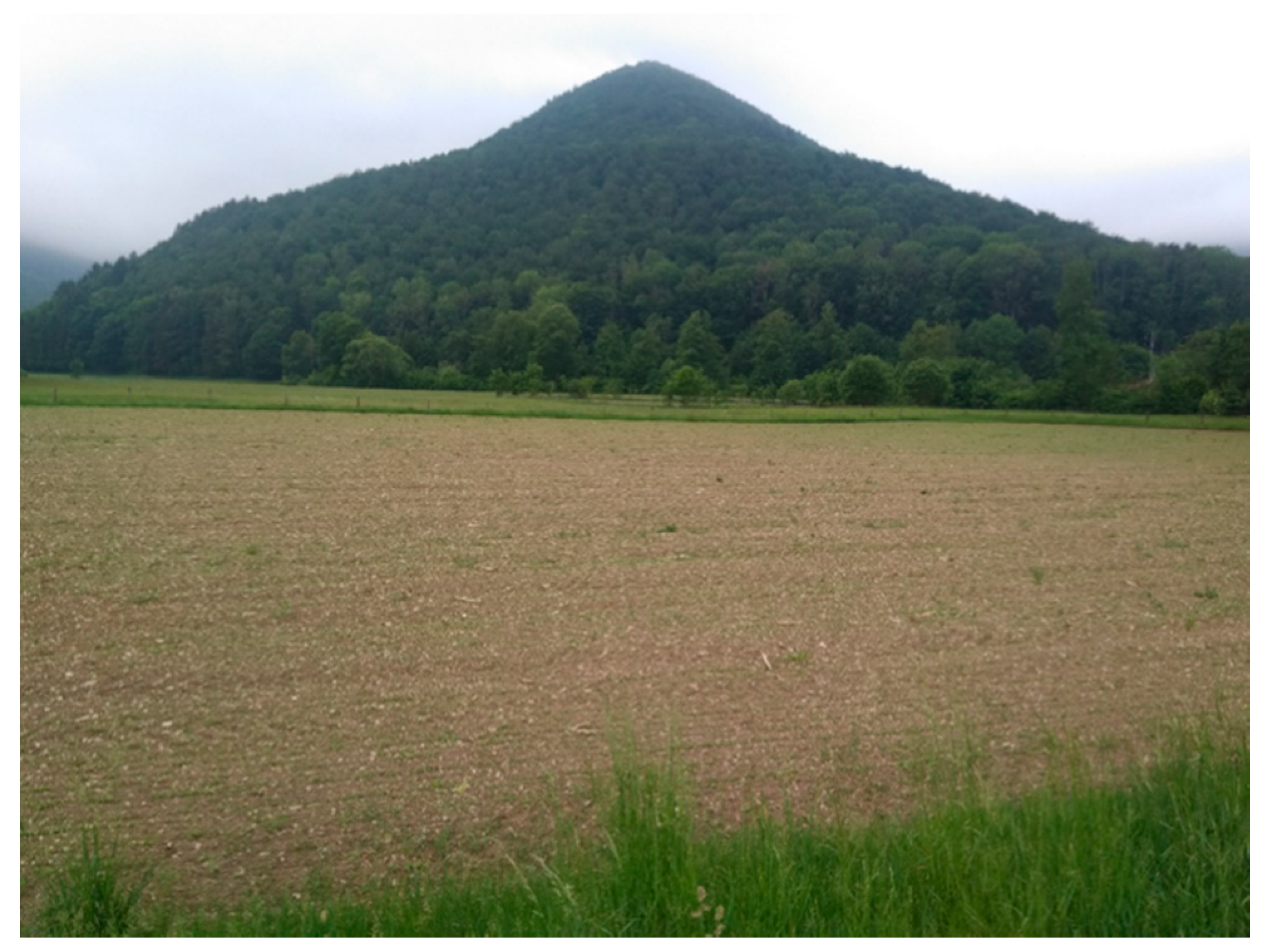
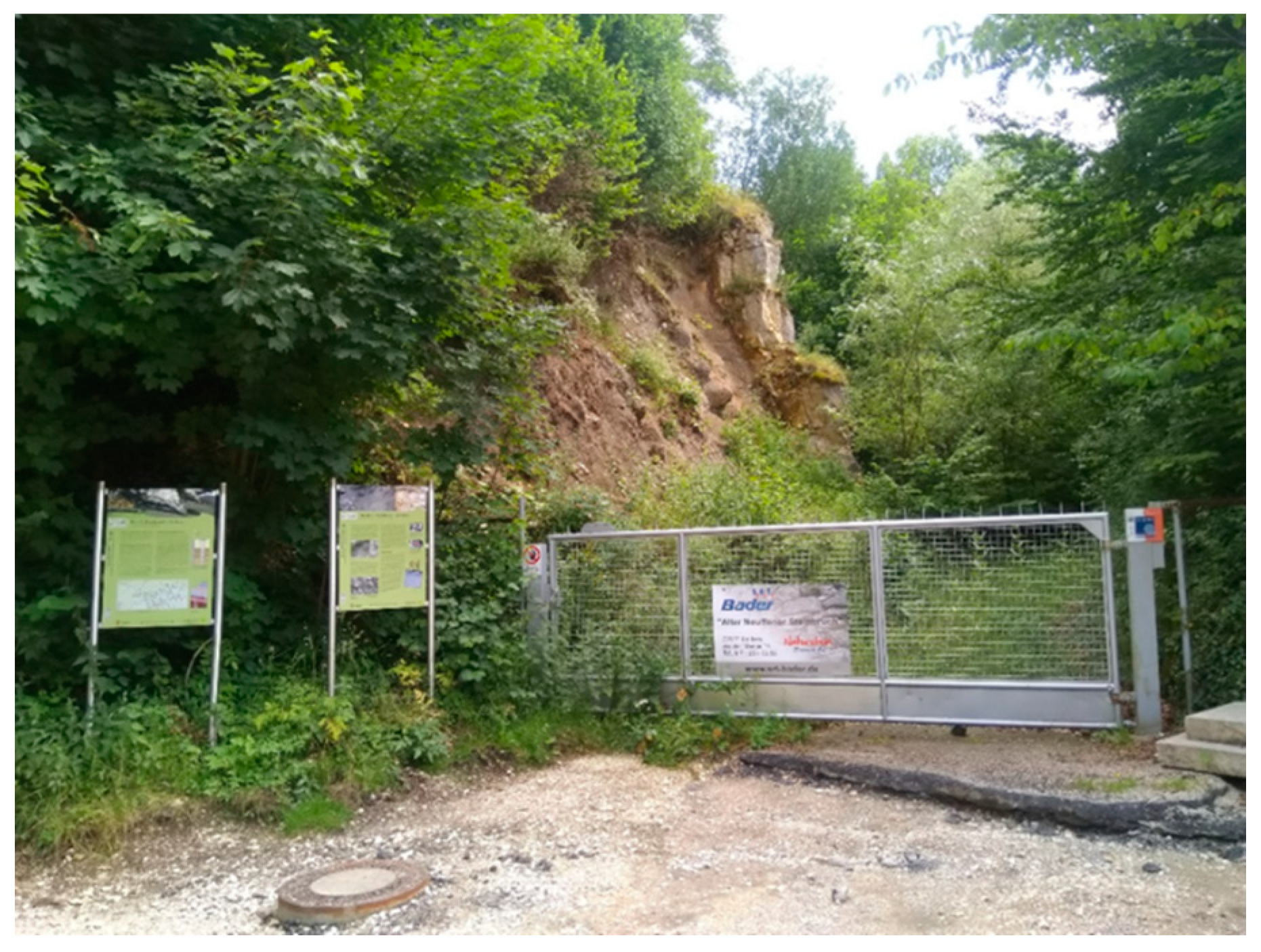
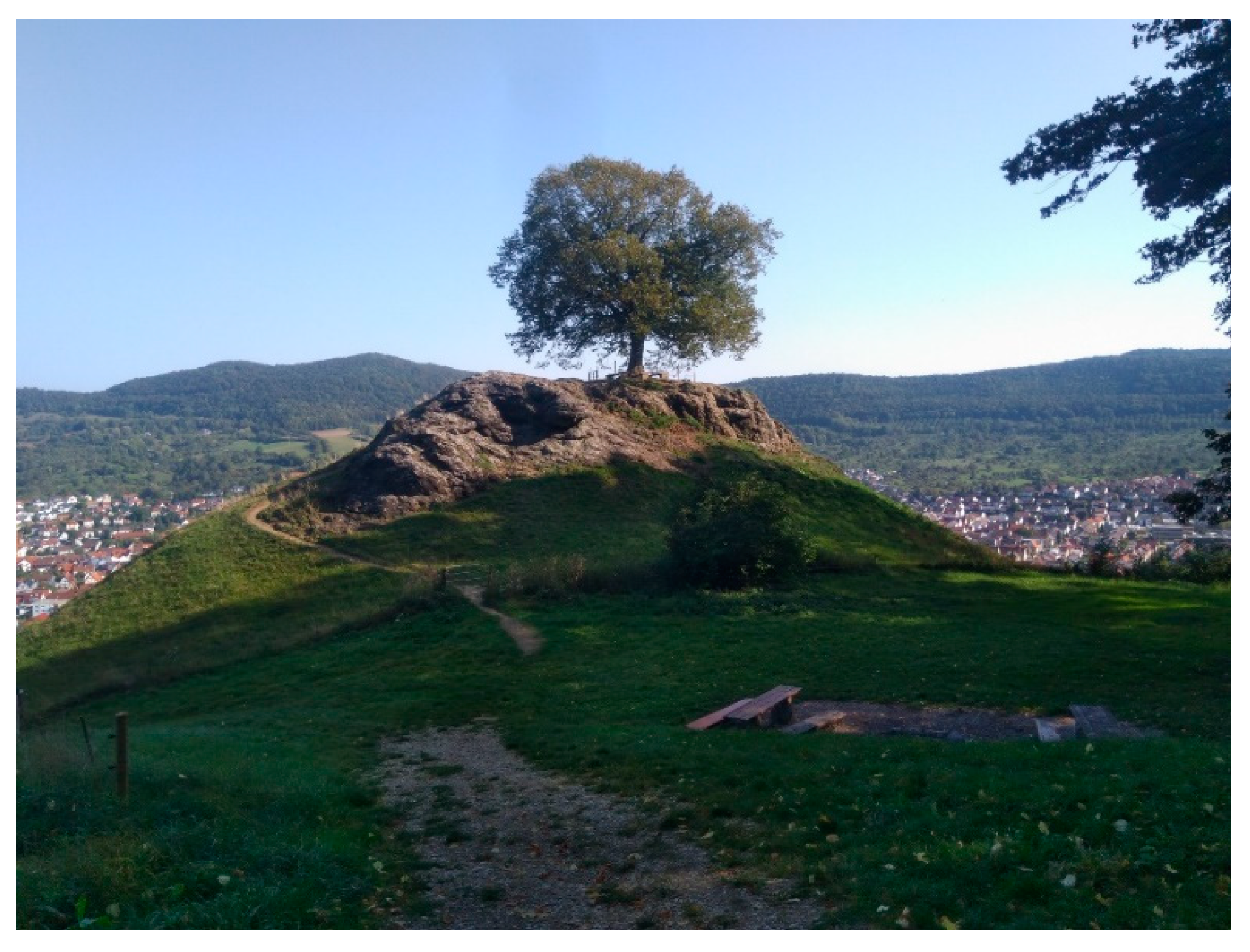
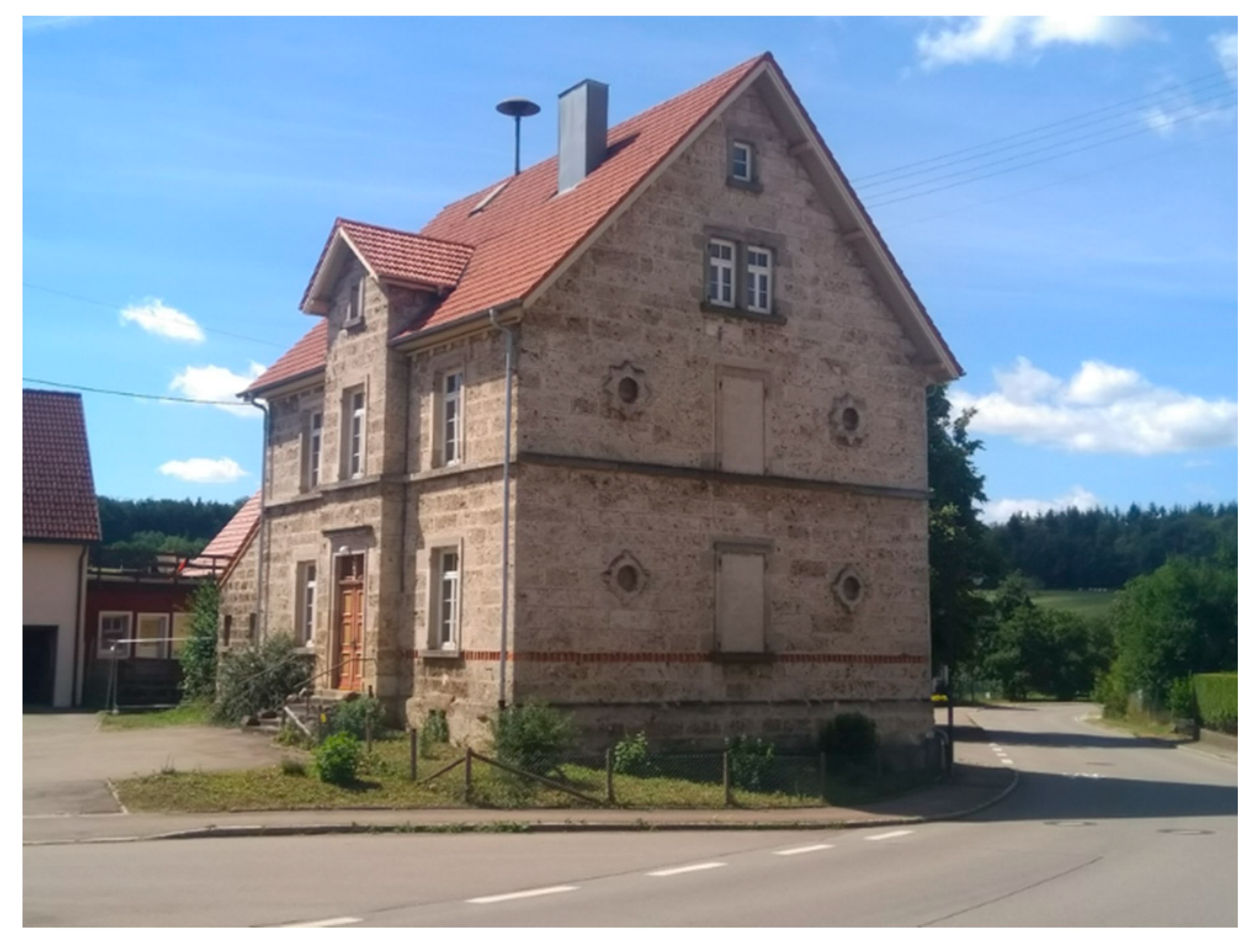

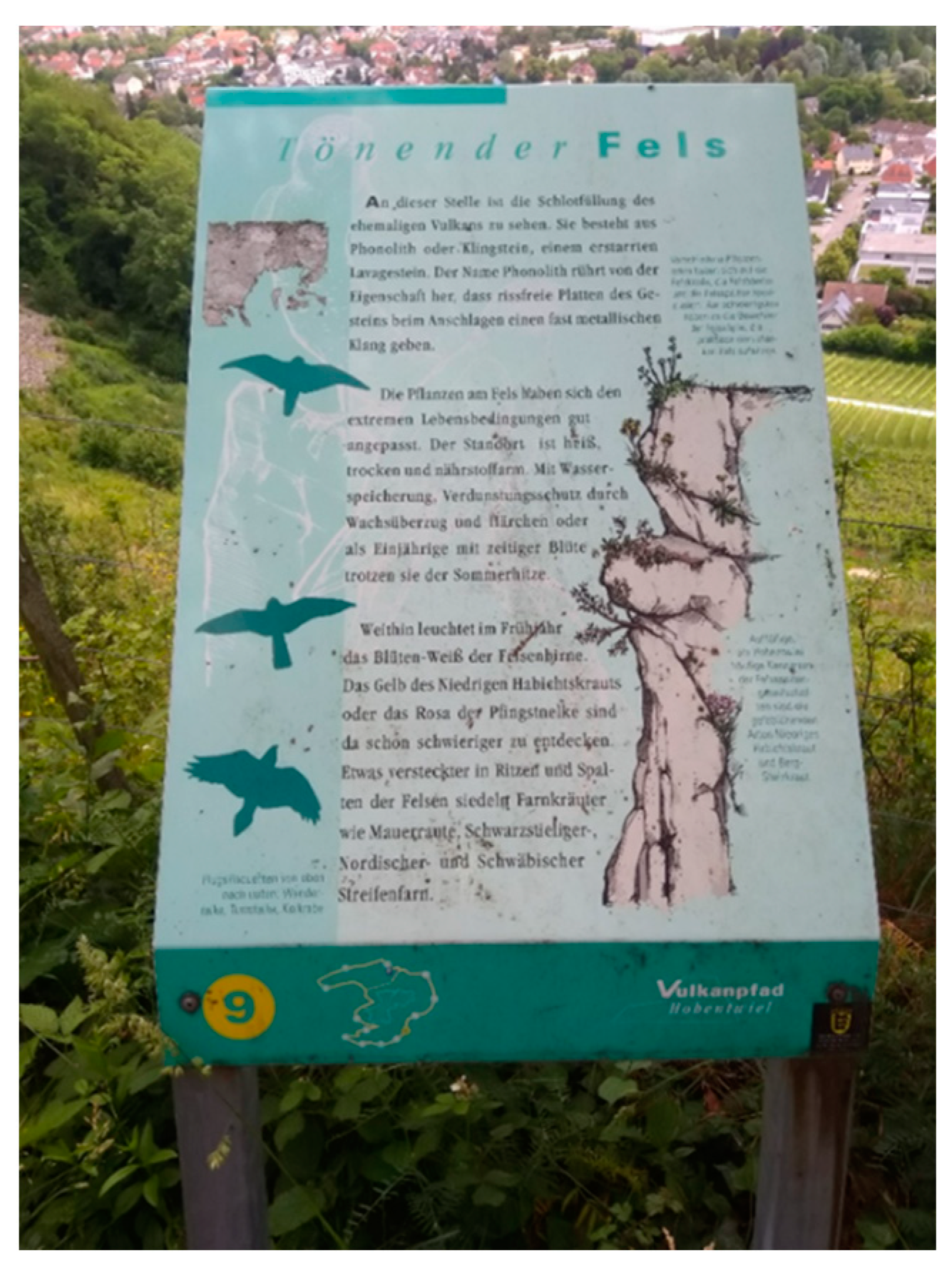
| Geopark | Category | Federal State | Volcanic Landforms | Main Topic | Geotourism (Selection) |
|---|---|---|---|---|---|
| Bayern-Böhmen | National Geopark | Bavaria (border-crossing with Czechia) | Tertiary and Quaternary volcanism of Eger Graben | Volcanism on front page 3 stars (Geoparks and volcanism 1) | Special offers for children both in general (How is a volcano formed?) as specific for the region. (https://www.geopark-bayern.de/Kinder/Vulkanismus/Vulkaninfos3.htm) Geotour “Volcanoes” (https://www.geopark-bayern.de/de/GEOVulkane/GTV_0.html) |
| Bergstraße Odenwald | National Geopark European Geopark UNESCO Global Geopark | Baden-Wuerttemberg, Bavaria, Hesse | UNESCO World Heritage Site Messel Pit: Fossil site in maar-sediments; Katzenbuckel, cretaceous volcano [20]; highest elevation of Odenwald; awarded geotop of the year 2013 | No direct mention of volcanism on homepage; No mention (Geoparks and volcanism) | Georoute Heidelberg: Volcanoes, deserts, earth quakes (https://geo-naturpark.net/deutsch-wAssets/docs/flyer/Heidelberg_Leporello.pdf) Geopark Trail: Fire and water (https://geo-naturpark.net/deutsch-wAssets/docs/geopfade/geopfad-moemlingen.pdf) |
| Grenzwelten | National Geopark | Hesse; North Rhine-Westphalia | Tertiary volcanism | National Geotop Bruchhauser Steine 1–2 stars (Geoparks and volcanism) | No direct mention of volcanism on homepage |
| Harz. Braunschweiger Land, Ostfalen | National Geopark European Geopark UNESCO Global Geopark | Lower Saxony; Saxony-Anhalt | Paleozoic volcanism (Devon, Karbon, Perm) | Volcanism on front page. Targeted search necessary for geological trails integrating volcanism 3 stars (Geoparks and volcanism) | Geological trail to volcanic cone Auerberg (https://geopark-hblo.de/standorte/geopfade/geopfad-am-auerberg/) Nearly no geotouristic offers integrating volcanic landforms |
| Inselsberg. Drei Gleichen | National Geopark | Thuringia | Volcanism of Rotliegend | No mention of volcanism on homepage; some research necessary to find geotouristic offers. 2 stars (Geoparks and volcanism) | Tabarzer Vulkansteig (https://www.bad-tabarz.de/wp-content/uploads/2017/08/Vulkanflyer_web.pdf) Haderholzroute with Porphyr (https://www.geopark-thueringen.de/fileadmin/user_upload/user/Georouten/routenfaltblatt_haderholzroute.pdf) |
| Kyffhäuser | National Geopark | Saxony-Anhalt; Thuringia | No volcanism | Nothing No star (Geoparks and volcanism) | No volcanic geotouristic offers. |
| Laacher See | National Geopark | Rhineland-Palatinate | Center of Tertiary and Quaternary volcanism of the Eifel | Volcanism in the name: Vulkanpark 4 stars (Geoparks and volcanism) | Comprehensive offers; Part of German Volcano Road (https://www.vulkanpark.com/geopark-laacher-see/dt-vulkanstrasse/), Information center Vulkanpark- (https://www.vulkanpark.com/infozentrum/) Lava-Dom in Mendig (https://www.vulkanpark.com/lava-domelavakeller/) |
| Muskauer Faltenbogen | National Geopark European Geopark UNESCO Global Geopark | Brandenburg, Saxony; border-crossing with Poland | No volcanism; | Nothing No star (Geoparks and volcanism) | No volcanic geotouristic offers. |
| Porphyrland | National Geopark | Saxony | Northwest Saxon volcanic complex; with 900 km2 one of the largest areas in Central Europe from the Rotliegend period | Very prominently on the homepage: “Land of the super volcanoes” 4 stars (Geoparks and volcanism) | Numerous offers, e.g., Georoute Porphyrlehrpfad (https://www.outdooractive.com/de/route/themenweg/region-leipzig/porphyrlehrpfad-auf-dem-rochlitzer-berg/21894939/) Guided tour “the super volcano below our feet” (https://www.geopark-porphyrland.de/geoerlebnis/buchbare-angebote/) |
| Ries | National Geopark | Bavaria; Baden-Wuerttemberg | No volcanism; | Nothing No star (Geoparks and volcanism) | No volcanic geotouristic offers. |
| Ruhrgebiet | National Geopark | North Rhine-Westphalia- | No volcanism; | Nothing 1 star (Geoparks and volcanism), but link runs nowhere | No volcanic geotouristic offers. |
| Schieferland | National Geopark | Bavaria; Thuringia | Underwater diabase volcanism (Devonian) | No mention on Homepage 3 stars (Geoparks and volcanism) | Two Geotrails: Geotrail Eisenberg (http://www.geopark-schieferland.de/files/133A6B83BB6/Ludwigsstadt_web.pdf) and Geotrail Steinachtal (http://www.geopark-schieferland.de/files/13239BC9227/Steinachtal_web.pdf) However, volcanism is only mentioned in a subordinate manner. |
| Swabian Alb (Schwäbische Alb) | National Geopark European Geopark UNESCO Global Geopark | Baden-Wuerttemberg | Tertiary volcanism (Swabian Volcano) | Mentioned on homepage, but much less prominent than the karst and cave phenomena 3 stars (Geoparks and volcanism) | Some offers like Volcano trail Münsingen-Apfelstetten (https://www.geopark-alb.de/de/Vulkankrater-Rundweg-M%C3%BCnsingen---Apfelstetten); Some guided tours as well as geopoints (https://www.geopark-alb.de/de/Naturwunder-H%C3%B6wenegg-ist-Geopoint??pid=0) |
| Terra Vita | National Geopark European Geopark UNESCO Global Geopark | Lower Saxony; North Rhine-Westphalia | No volcanism; | Nothing No star (Geoparks and volcanism) | No volcanic geotouristic offers. |
| Vulkaneifel | National Geopark European Geopark UNESCO Global Geopark | Rhineland-Palatinate | Extensive Tertiary and Quaternary volcanism; numerous maars | Volcanism in the name: Vulkaneifel 2–4 stars (Geoparks and volcanism) | Great variety of volcanic offers, e.g., museums (https://www.geopark-vulkaneifel.de/geo-museen/vulkanhaus-strohn-mit-vulkancafe.html), trails, guided tours, etc. |
| Westerwald-Lahn-Taunus | National Geopark | Hesse; Rhineland-Palatinate | Tertiary volcanism with large basalt coverings | Difficult to find on homepage. 3 stars (Geoparks and volcanism) | Integration of volcanism in georoutes, e.g., (https://geopark-wlt.de/georoute-vom-teufelsberg-zur-caaner-schweiz) and some geopoints like (https://geopark-wlt.de/basaltpark-2) |
| National Geotop | Federal State | Volcanic Landforms | Geotouristic Valorization | Other Remarks |
|---|---|---|---|---|
| Hexentanzplatz and Rosstrappe | Saxony-Anhalt; Harz | Diabase as the remains of a submarine volcanism | Volcanic geoheritage only plays a very minor role. | |
| Siebengebirge | North Rhine-Westphalia | Tertiary volcanism | Geological hiking tours | Building blocks, e.g., for Cologne Cathedral Oldest nature reserve in Germany [50] |
| Bruchhauser Steine | North Rhine-Westphalia | Devonian volcanism | Mentioned as geotope on the homepage of the Geopark Grenzwelten Information center; 2015: 15,000 visitors, 1000 of whom booked a guided tour | Oldest ramparts of the region on the main rock |
| Messel Pit | Hesse | Volcanic Maar | Geo-Naturpark Bergstraße-Odenwald (see Section 3.2). Visitor and information center since 2010; Guided tours and information boards; approx. 100,000 visitors per year | UNESCO World Heritage Site due to fossils |
| Blockhalde am Schafstein | Hesse | Tertiary volcanism, Basalt stone run | Hiking tours with information boards | Biosphere Reserve Rhön |
| Feldstein | Thuringia | Tertiary volcanism 12m high Basalt rock | Popular name as devil’s stone; local sagas and legends about the origin | |
| Scheibenberg | Saxony Erzgebirge | Tertiary volcanism Basalt columns | Observation tower on the summit | World famous through the Neptunist dispute 200 years ago. |
| Palmwedel | Saxony Erzgebirge | Tertiary volcanism Basalt columns | Fomer quarry opened for the public and with an explanation board | Local sagas and legends about the origin |
| Basaltschlot des Burgbergs von Stolpen | Saxony Lausitz | Tertiary volcanism Basalt dome | Guided tours to the castle | Stolpen Castle on the dome Outstanding importance in the scientific research of basalt. Agricola used the term basalt for the first time in 1546 [49]. |
| Elbsandsteingebirge | Saxony | Mainly sediments, some Tertiary volcanism with Basalt | Tourist hotspot, but volcanism only plays a minor role | National Park Sächsische Schweiz Very high number of tourists; At times overtourism with all the associated disadvantages. |
| Porphyrtuff Rochlitz | Saxony | Part of the more than 2000 km2 large volcanic area of the Rotliegend period. Ignimbrite, popularly known as Rochlitzer Porphyrtuff | Porphyr educational trail | Building material since the 10th century, typically for numerous cities and buildings in the area |
| Dauner Maar | Rhineland-Palatinate UNESCO Global Geopark Vulkaneifel | Tertiary and Quaternary volcanism Volcanic Maars | Museum Daun; Hiking tours | |
| Land der Vulkane | Rhineland-Palatinate UNESCO Global Geopark Vulkaneifel | Tertiary and Quaternary volcanism Maars, volcanic cones | See Section 3.1 | Use of volcanic tuff as building blocks Meurin Roman mine as one of the last remaining ancient tunnel systems. Unique monument of technology history. |
| Druidenstein | Rhineland-Palatinate | Tertiary volcanism Basalt columns | Hiking tour | At times used as a quarry Local sagas and myths about the origin |
| Geysir Andernach | Rhineland-Palatinate | Aftermaths of Tertiary volcanism Geysir | Touristic destination since 1912 | |
| Kaiserstuhl | Baden-Wuerttemberg | Miocene volcanism; Ruin of a volcano because of erosion | Nature center and numerous nature trails, but mainly due to the special fauna and flora (see Section 4.2) | Some deep rocks were first described here, e.g., Mondhaldeit or Bergalit [49]. Used for viticulture since Roman times |
| Randecker Maar | Baden-Wuerttemberg UNESCO Global Geopark Swabian Alb | Miocene volcanism Maar, Part of Swabian Volcano | Nature conservation center with exhibition; (see Section 4.1) | Great importance as a fossil site and for bird migration |
| Hegau-Vulkane | Baden-Wuerttemberg | Tertiary volcanism Basalt- and Phonolith cones | Volcano trail (adventure trail); Volcano tours, guided tours (see Section 4.3) | Numerous castles on the hilltops. Fossil site Höwenegg with worldwide significance. |
| Hoher Parkstein | Bavaria | Tertiary volcanism Basalt columns | Guided tours; hiking trails; geological trail | Early dismantling as road gravel; belongs to the hundred most beautiful geotopes in Bavaria |
Publisher’s Note: MDPI stays neutral with regard to jurisdictional claims in published maps and institutional affiliations. |
© 2020 by the author. Licensee MDPI, Basel, Switzerland. This article is an open access article distributed under the terms and conditions of the Creative Commons Attribution (CC BY) license (http://creativecommons.org/licenses/by/4.0/).
Share and Cite
Megerle, H.E. Geoheritage and Geotourism in Regions with Extinct Volcanism in Germany; Case Study Southwest Germany with UNESCO Global Geopark Swabian Alb. Geosciences 2020, 10, 445. https://doi.org/10.3390/geosciences10110445
Megerle HE. Geoheritage and Geotourism in Regions with Extinct Volcanism in Germany; Case Study Southwest Germany with UNESCO Global Geopark Swabian Alb. Geosciences. 2020; 10(11):445. https://doi.org/10.3390/geosciences10110445
Chicago/Turabian StyleMegerle, Heidi Elisabeth. 2020. "Geoheritage and Geotourism in Regions with Extinct Volcanism in Germany; Case Study Southwest Germany with UNESCO Global Geopark Swabian Alb" Geosciences 10, no. 11: 445. https://doi.org/10.3390/geosciences10110445
APA StyleMegerle, H. E. (2020). Geoheritage and Geotourism in Regions with Extinct Volcanism in Germany; Case Study Southwest Germany with UNESCO Global Geopark Swabian Alb. Geosciences, 10(11), 445. https://doi.org/10.3390/geosciences10110445




